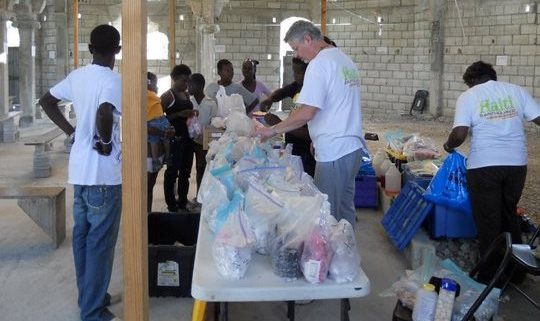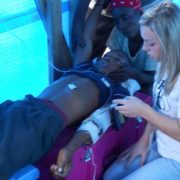Eleven Days in Haiti: Part 3 – Ziplock Pharmacy
This is part 3 of the “Eleven Days in Haiti” series that started here: https://fbcbridgeport.org/eleven-days-haiti-part-1-series-intro. Be sure to get caught up if you missed the prior post!
DAY 1—ZIPLOCK PHARMACY
Awoke at 5:00am, unless you count the numerous times the resident rooster crowed beginning about 3 hours earlier. After loading the vans with supplies, we headed out for our first clinic location. In truly a case of “a picture is worth a thousand words”, you just have to see it. The “clinic” was a shell of a block building with a tarp roof. No glass in any windows. No doors, only doorways. I believe the building is used as a church. There are rows of benches for our patients to use while they wait to see the doctors who sit along the wall in a folding chair flanked by a translator. The patient sits in a chair opposite the doctor. In most cases, all communication is through the translator regarding symptoms, complaints, and treatments. Any examination is done on the spot with little to no privacy. There are no labs, x-rays, MRI, or urinalysis. Medical records are scant. Many don’t know their birthdate or how old they are. The doctors make their best diagnosis based on the most basic of knowledge—a gross exam, a blood pressure, temperature, blood sugar and a verbal collection of symptoms translated from Creole—then prescribe appropriate medications on a small legal pad. The “prescription” is then brought by the patient to the pharmacy area where the pharmacy workers interpret the order, dispense the proper medication, and the translator tells the patient how to use the medication.
Since a large percentage of the population doesn’t read, a permanent marker is used to mark a symbol system onto the ziplock bags used to dispense the meds.
One circle, representing a dose, means 1 dose daily. Two circles means two doses daily. A fractional symbol with two circles over three circles would mean “two tablets three times daily.” Most of our stock of medications was stored in large ziplock bags. Most of the large bags were labeled only with the name and strength of the medication. Inside most were smaller ziplock bags, containing pre-counted quantities of the drug, intended to represent a course of therapy. Most chronic meds were 30-day supplies. Lesser amounts of antibiotics, antacids, anti-inflammatories were dispensed. There were few liquid bottles, so liquid meds were dispensed in empty stock bottles from tablets or capsules. Many creams and ointments were dispensed in zip-lock bags, or stock tubes.









